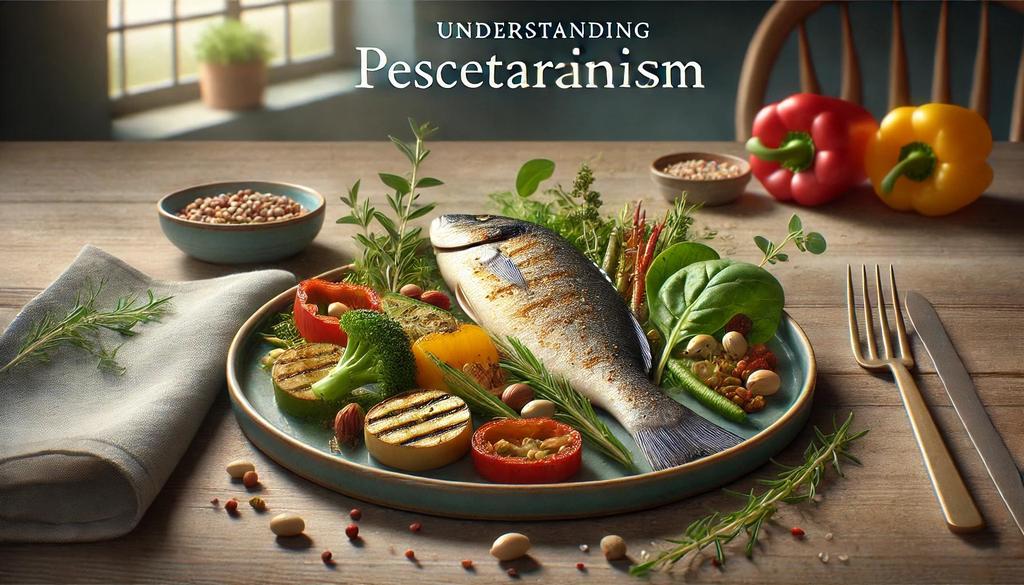In today’s world of diet trends and food philosophies, there may come a point when you hear yet another term that piques your curiosity—pescetarianism. If you’ve ever wondered what it is, you’re in good company. Many people are exploring different dietary paths that align closely with personal ethics, health goals, or even environmental concerns.
Pescetarianism, at its core, is a flexible diet that melds the best of plant-based eating with the nutritional punch of seafood. Think of it as a middle ground between being vegetarian and diving into omnivorous habits. While the conversation around diets is as dynamic as ever, understanding where pescetarianism fits in and why it’s gaining traction can offer valuable insights into our evolving eating habits.
With health benefits such as improved heart health and reduced risks of certain chronic diseases, pescetarianism is catching the attention of many who are consciously looking to improve their health through diet. As we dive in, we’ll not only define pescetarianism and its origins but explore its historical roots and how it’s dovetailing into present-day eating narratives. You’ll finally be able to answer the question, “What can I eat on a pescetarian diet?”
I. Understanding Pescetarianism
At its essence, pescetarianism is a dietary practice where one supplements a vegetarian diet with fish and seafood. Imagine your everyday vegetarian plate with a vibrant addition of seafood flavors. The term itself is a linguistic blend—a portmanteau, if you will—of the Italian word “pesce” (meaning fish) and “vegetarian.” Emerging in lexicons around the late 1980s, pescetarianism offered an alternative for those wanting the nutritional benefits of seafood while adhering largely to a plant-based regimen.
The roots of pescetarianism, however, stretch much further back. Some ancient cultures, such as those influenced by Pythagorean philosophies, may have practiced what we’d now recognize as a pescetarian lifestyle. Historically, various religious and philosophical teachings touted the merits of fish consumption over other meats. Throughout medieval times, several monastic orders advocated diets rich in fish and plant-based foods, imposing restrictions on land animal consumption.
Pescetarianism vs. Other Diets
While pescetarianism shares some similarities with vegetarianism, the critical distinction lies in seafood inclusion. Unlike vegetarians, pescetarians include fish in their diets, thereby easing the path for those seeking nutritional elements like omega-3 fatty acids. It’s less restrictive than veganism, which excludes all animal-derived products, offering a balanced approach between adhering to dietary discipline without entirely giving up animal proteins.
When compared to the flexitarian diet—a concept that encourages plant-based meals with occasional meat consumption—pescetarianism stands out for its consistent inclusion of seafood. This flexibility often appeals to those who prioritize heart health, given that fish consumption has been linked to reduced risks of cardiovascular diseases.

II. Evolution and Current Pescetarian Trends
Historical to Modern-Day Trends
Tracing the journey of pescetarianism from history to the current age is like watching a tapestry unfold, with every weave carrying cultural significance. Historically, various cultures embraced fish as part of their diets, frequently as a necessity due to geographic constraints or religious edicts. For example, fish has always been a cornerstone in Japanese cuisine, offering a wealth of nutritional benefits that the land’s limited agricultural scope couldn’t always provide.
Modern pescetarianism leverages these ancient practices but with a contemporary twist. Today’s pescetarian adheres to tradition while embracing innovations in food sustainability and ethical sourcing. This dietary pattern has palpably increased in popularity since the mid-2010s, thanks to growing awareness of dietary impacts on both health and the environment.
Integration with Flexitarianism
Flexitarianism and pescetarianism share the spotlight when it comes to modern, adaptable diets. While both emphasize plant-based nourishment, they offer consumers flexibility—which is critical in a culture of diverse dietary needs and personal preferences. This integration allows individuals to adjust their dietary intake based on health objectives while without entirely relinquishing meat.
Flexitarian principles often lay a foundation upon which pescetarianism can thrive, providing a structured yet adaptable eating plan that resonates with those committed to reducing their carbon footprint by lowering red meat consumption. It’s this accessibility and practicality that make the pescetarian option appealing to a broader demographic.
As the culinary scene continues to embrace these dietary shifts, both pescetarianism and flexitarianism promise a future of flexible eating—balancing personal health, taste, and sustainability in harmonious alignment.
By understanding these facets of pescetarianism, we can better appreciate its role on our plates and how it continues to weave into the broader landscape of dietary culture. This insight equips us to make informed, holistic choices that harmonize health with ethical and environmental consciousness.

III. Fish Based Diet Health Benefits and Nutritional Aspects
Nutritional Profile and Health Impacts
A pescetarian diet can offer a wealth of health benefits, particularly when centered around the combination of high-quality seafood and plant-based foods. One of the standout features of this diet is its richness in omega-3 fatty acids, primarily sourced from fish like salmon, herring, and trout.
Omega-3s are important fats that our bodies cannot produce, vital for heart and brain health, reducing inflammation, and potentially lowering blood pressure. Their anti-inflammatory properties are recognized for preventing conditions like heart attacks and strokes, making fish a powerhouse in the fight against cardiovascular disease.
In addition to seafood, a pescetarian diet includes a variety of fruits, vegetables, legumes, and whole grains, each contributing to different health benefits. These plant-based foods are rich in fiber and antioxidants, which play a crucial role in digestion, maintaining healthy cholesterol levels, and reducing the risk of certain cancers. Combined, these foods foster a nutrient-dense diet that can support overall well-being and longevity.
Interestingly, studies have shown that pescetarians may experience lower rates of heart disease compared to those who consume meat regularly. This can be attributed to consuming less saturated fat, typically found in red meat, and more heart-friendly fats from fish. Moreover, the vibrant colors in fruits and vegetables are often indicators of phytonutrients, compounds that have protective effects on heart health.
Potential Pitfalls and Nutrient Considerations
Despite its advantages, the pescetarian diet requires careful planning to ensure nutritional balance. One must be mindful of potential deficiencies that can arise from reduced or absent consumption of meats and certain animal products. Notably, nutrients like vitamin B12, iron, and zinc, which are predominantly found in red meat, need attention.
- Vitamin B12 is crucial for nerve function and the production of DNA and red blood cells. Since it’s largely found in animal products, pescetarians may still obtain B12 through fish and fortified foods, but monitoring intake is wise.
- Iron, necessary for transporting oxygen in the blood, exists in two forms: heme (from animal sources) and non-heme (from plant sources). While fish provides heme iron, it’s accompanied by non-heme iron from beans and lentils, whose absorption is enhanced by vitamin C-rich foods like citrus fruits.
- Zinc, which supports immunity and wound healing, may also require attention. While seafood contains zinc, incorporating additional plant sources such as nuts and seeds can help cover any gaps.
- Calcium and omega-3 fatty acids should also be ensured, particularly if one’s diet limits dairy.
Fish is a good source of these nutrients, and they can be supplemented by fortified plant-based options if necessary.
While the pescetarian diet is robust in essential nutrients, being conscious of potential gaps ensures a well-rounded nutritional intake. Consulting with a healthcare professional or registered dietitian can provide guidance tailored to personal dietary needs, helping to devise a meal plan that captures all necessary nutrients, supporting a healthy and thriving lifestyle.
By understanding these nutritional facets, individuals embracing pescetarianism can enjoy a varied and healthful diet, maximizing the benefits of seafood and plant foods while ensuring a balanced intake of all essential nutrients.

IV. Dynamic Food Options and Market Availability of Fish
Current Culinary Landscape
With its increasing popularity, the pescetarian lifestyle comes with a wide array of culinary delights and diverse markets that cater to those who savor both plant-based and seafood-rich diets. From bustling markets to innovative dining spots, pescetarians can enjoy a vibrant and flavorful spectrum of food choices.
One notable aspect of pescetarianism is its natural alignment with many global culinary traditions. For instance, Japan stands out as a quintessential pescetarian paradise, where seafood is an integral part of the daily diet. In places like the Tsukiji Fish Market in Tokyo, visitors are treated to a dazzling display of fresh seafood—from colossal tuna to delicate sashimi—embodying pescetarian cuisine’s nutritious and savory heart. This love for seafood translates into various dining options across Japan, where fish is celebrated in myriad ways, be it raw, cooked, or fermented.
The presence of readily available seafood in local supermarkets and specialty stores further underscores the global reach of pescetarianism. In many urban areas, you can find pre-packaged sushi, fresh fish fillets, canned tuna, and an assortment of seafood options that simplify the incorporation of these items into everyday meals. Accessibility has made it easier for people to embrace pescetarianism, inspiring creative culinary experimentation in home kitchens.
Practical Feeding Ideas and Recipes
Adopting a pescetarian lifestyle opens the door to numerous culinary possibilities that blend the richness of seafood with the wholesome goodness of plant-based foods. Whether you are a seasoned cook or a kitchen novice, there are plenty of recipes that cater to varying tastes and preferences.
- For breakfast, why not start the day with a vibrant smoothie bowl topped with chia seeds and mixed berries? This nutrient-rich meal provides a refreshing burst of vitamins and antioxidants.
- Lunch can be as simple as a grain bowl filled with quinoa, roasted vegetables, and grilled shrimp. This combination ensures a balance of flavors and nutrients, along with ample protein and fiber to keep you energized throughout the day.
- Dinner might be the ideal time to get a bit more adventurous. Consider a dish like salmon baked with a herb crust or a hearty seafood stew filled with mussels, clams, and white fish simmered in a fragrant tomato broth.
- Pair these dishes with a side of leafy greens or a fresh salad to enhance the meal’s nutritional profile further.
The beauty of pescetarian cooking lies in its flexibility—numerous recipes can be adjusted to include seasonal ingredients or tailored to fit specific dietary needs. Moreover, the availability of international culinary influences means that pescetarians can enjoy flavors spanning continents, making each meal an exploration of taste and texture.
By taking advantage of the dynamic food landscape available to pescetarians, individuals can enjoy a diet that is not only healthy but also deeply satisfying and enriched by the endless versatility of global cuisines. The availability of diverse food options ensures that pescetarians can thrive in their dietary choices, nourishing both their bodies and their culinary curiosity.

V. Ethical and Environmental Considerations
As our understanding of animal welfare deepens, many are drawn to pescetarianism for its perceived ethical benefits. Compared to traditional meat-eating diets, pescetarianism often involves fewer land animals, addressing some ethical concerns associated with factory farming. Factory farming involves keeping a large number of animals in crowded, often inhumane, conditions to maximize production. Many see pescetarianism as a more humane choice because it typically avoids these practices and focuses instead on fish and seafood, which some perceive as experiencing less suffering during harvesting.
However, ethical questions do not entirely vanish with fish consumption. Recent research suggests that fish can experience pain and emotions, sparking debate on the moral implications of eating fish. As people become more aware of these studies, they are urging more humane treatment for fish through innovative capture and rearing practices. For individuals who are deeply concerned with animal welfare but still wish to include some animal protein in their diet, pescetarianism can serve as a transitional or compromise diet, encouraging them to consume seafood responsibly.
Environmental Impact
From an environmental standpoint, pescetarianism is often lauded for its lower carbon footprint compared to diets heavy in red and processed meats. The production of fish generally requires fewer resources, such as land and water, which contributes less to greenhouse gas emissions. This reduction makes pescetarianism an appealing option for those striving to reduce their environmental impact and contribute to a more sustainable planet.
However, it is essential to recognize that not all seafood is created equal. Overfishing and unsustainable seafood harvesting methods can damage marine ecosystems, leading to depleted fish stocks and habitat destruction. As a result, choosing sustainably caught or responsibly farmed fish is crucial for maintaining the balance of marine environments. Consumers can make informed decisions by looking for eco-labels that certify sustainable seafood or by consulting guides such as the Seafood Watch, which helps identify environmentally friendly seafood options.
In balancing ethical and environmental considerations, pescetarianism offers a dietary approach that can be attuned to both personal values and the health of our planet, provided consumers are mindful of their seafood choices.

VI. The Future of Pescetarianism
As more people become aware of dietary impacts on health, ethics, and the environment, pescetarianism finds itself at the heart of this transformative conversation. The future of this diet is likely to see greater integration into mainstream eating, spurred by innovations in sustainable fish farming and increased consumer demand for ethical foods.
Technological advancements in aquaculture—raising fish in controlled environments—can play a vital role in providing a consistent supply of seafood without depleting wild populations. As these methods become more efficient and environmentally friendly, they hold the promise of making seafood an even more accessible and responsible choice for consumers.
Furthermore, the growing interest in plant-based diets complements pescetarianism’s trajectory. As people explore the health benefits and moral considerations associated with reducing animal consumption, the pescetarian diet acts as an adaptable middle ground that can attract those transitioning toward more sustainable eating habits.
As societal tastes evolve, the pescetarian diet could become a prominent part of future food narratives—championing diversity, sustainability, and the balance of nutritional needs with ethical and environmental sensibilities.

Pescetarianism for Ethical Eating and Healthier Living
In navigating the intricate world of dietary choices, pescetarianism shines as a balanced approach that marries healthier living with ethical and environmental consciousness. By embracing both plant-based foods and the nutritional bounty of seafood, pescetarians can enjoy a diet that supports heart health, provides essential nutrients, and aligns with personal values.
However, like any lifestyle choice, mindful engagement is key. By prioritizing sustainably sourced seafood and being aware of nutritional needs, pescetarians can cultivate a diet that’s both nourishing and responsible. Looking forward, innovations in food production and a cultural shift towards sustainability promise an exciting future for pescetarianism—as it continues to empower individuals seeking harmony between their dietary habits and the greater world.
Ultimately, whether you’re partially curious, ethically motivated, or health-driven, exploring pescetarianism is more than a dietary choice—it’s an invitation to engage with food in a way that fosters personal well-being and a healthy planet.




